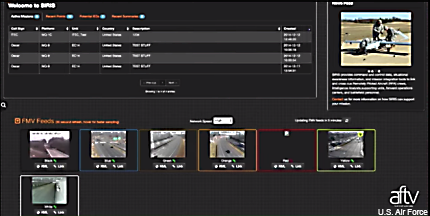Air Force team develops innovative RPA collaboration system
The Web-based Surveillance Intelligence Reconnaissance Information System revamps the way remotely piloted aircraft crews collaborate.

A screen capture from an Air Force video shows SIRIS in use.
A group of resourceful Air Force intelligence experts are being recognized for taking existing technology and developing a Web-based system that makes collaboration on unmanned aircraft operations a lot easier for air, ground and intelligence users.
The team will receive the U.S. Geospatial Intelligence Foundation Achievement Award for their work in developing the Surveillance Intelligence Reconnaissance Information System, or SIRIS. Requiring only a Web browser and access to Google Earth, SIRIS revamps the way in which remotely piloted aircraft – the Air Force’s preferred term for drones – crews share information, including imagery, full-motion video, mission planning files, aircraft locations, sensor points of interest, signals intelligence and weather.
Young airman and pilots were restricted by existing platforms and technologies because they “did not permit a shared intelligence picture, limiting the ability to collaborate with each other,” Col. Frances Deutch, Ph.D., the Intelligence Innovation Programs director, said in an Air Force news release.
“We chose a Web-based solution that does not require a costly retrofit of the platform, and we created rapid, sustainable innovations that were non-compartmentalized,” said Stephen Coffey, an RPA subject matter expert at the Air Force’s ISR Innovations Directorate.
Air Force researchers enhanced SIRIS’ capability by expanding its Internet Coordinate Extractor, or ICE, program, which can monitor several chat rooms at once and plots valuable information on Google Earth for crews. This feature saves not only money but lives, Coffey said, because “ICE allowed us to focus on Google Earth in the moment, so instead of looking at six computer displays, I’d look at one.” RPA crews, with the advent of the ICE concept, could receive visual threat warnings right on their map displays as opposed to scouring chat rooms for intelligence – a first of its kind occurrence.
Experts and researchers have larger plans for RPAs other than providing intelligence, surveillance, reconnaissance and close air support, especially as threat awareness and threat detection continue to emerge in more sustainable platforms. “We’re trying to get the user in front of the technology, then they can tell us in a more succinct and specific manner what information they need,” Coffey said.
The SIRIS program was also used domestically to help first responders combat forest fires in Yosemite National Park in California, relaying images collected by the California National Guard’s Predator drones to local fire fighters. The SIRIS program assisted in imagery, video and collaboration with teams responding to the incident.
Also worth noting, according to reports by the Air Force Times, the initial Air Force release indicated that this particular application was adjusted following the shoot-down of a Predator belonging to European Command in Syria as part of Operation Inherent Resolve. The acknowledgement by the Air Force in the release that the Predator was shot down in the Syrian border town of Latakia, likely by Syrian forces but it is still unclear, was the first time the military publically stated the aircraft was shot down. The Air Force Times also discovered that following its initial report, the Air Force actually removed language referencing the March incident involving EUCOM’s Predator drone.
"Applying technology without the skill craft … had atrophied for us, since RPAs had not been shot at for 20 years… Time was not our friend in this particular case, so it's important that we had an early adoption of the technology,” the report quoted Coffey as saying in the initial Air Force release. “The March shoot-down was among the first times remotely piloted aircraft had been shot at,” the report stated, relying again on Coffey’s comments in the initial release.